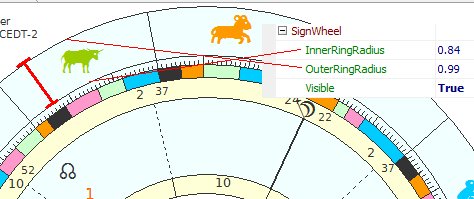InnerRingRadius and OuterRingRadius
All Wheels have these 2 properties in common and I have drawn a red line from the property in the Wheels section to the location of that part of the wheel as shown below:

I have used the sign Taurus (the bull) to illustrate here. The radius is measured as a fraction of how far away from the center the circular line is drawn so the OuterRingRadius of a wheel should always be greater than the InnerRingRadius of that wheel (if not, it will not draw correctly). These values must always be between 0.0 and 1.0. For example the InnerRingRadius is 0.84 for the SignWheel, this means that if there was a line drawn from the center of the circle to the outermost extreme, and you divided this into 100 equal sections, this circular line would be intersecting the 84th division as counting from the center because a radius of 0 is the center and a radius of 1 is the outermost extreme.
In this way you can control the width or narrowness of the wheels that are drawn. A wider wheel suggests more space and therefore a larger font used for glyphs in many cases.
I recommend that in most cases you match the InnerRingRadius of the Wheel outside to the OuterRingRadius of the wheel showing just inside this so that the lines won't double up. For now the Wheels must always come in this order of drawing (until I define a user defined drawing order):
SignWheel
TickWheel
BoundWheel
HouseWheel
PlanetWheel(s) (1..4) - if 4 charts are shown then PlanetWheel4 is outside of PlanetWheel3, etc...
NumberWheel
AspectWheel
Not all wheels need to be visible. If BoundWheel.Visible = False, then match the InnerRingRadius of the TickWheel to the OuterRingRadius of the HouseWheel, because only visible wheels are drawn.
